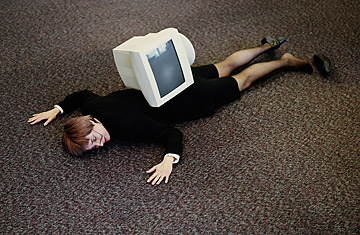
As ergonomics specialists know, using a computer can be a real pain — in the neck, wrists, back, eyes, shoulders, etc. But it also leads to injuries that experts may not have considered, such as trips and falls over the printer cord, lacerations from the sharp corners of a CPU or bruised toes from dropping laptops on feet.
Accidents like these happen more often than you think. According to a study published in the July issue of the American Journal of Preventive Medicine — the first to tally acute computer-caused injuries like cuts and bruises — 9,300 Americans suffer such mishaps each year. Based on data from some 100 hospital emergency rooms across the country from 1994 to 2006, the study found that 78,703 people sustained injuries ranging from scrapes and bruises to contusions and torn muscles during the 13-year study period. (Watch a video about dropping your laptop from 3 ft. off the ground.)
In part, the high rate of injury reflects the sheer increase in household computer ownership, which jumped 309% over the same period. But computer exposure and injuries hardly rose in lockstep: injuries far outpaced ownership, growing 732% from 1994 to 2006.
"I found that to be really astounding," says study co-author Lara McKenzie, assistant professor of pediatrics at Nationwide Children's Hospital's Center for Injury Research and Policy. "We never see increases like that, and we look at consumer products all the time."
The study showed that the majority of computer-related injuries — 93% — happened at home. In all age groups, the most frequently diagnosed injury was laceration, making up 39% of cases. For adults, the leading cause of injury was hitting or getting caught on a part of a computer (37% of cases). Falling computer equipment accounted for 21% of cases, the second highest cause of injury, and among adults, hands, feet, arms and legs were the most frequently wounded parts of the body, making up 57% of all injuries. (See pictures of vintage computers.)
In cases where there were available data on the type of activity that led to injury, researchers found the most common way adults hurt themselves — 50% of incidents — was while moving the computer or one of its components, defined by the researchers as anything from a mouse or keyboard to a scanner or piece of computer furniture. Children, on the other hand, got hurt most often by climbing on or playing near computer equipment. Injuries among small children accounted for a disproportionate number of all accidents, which most concerned the study's authors. "Children under age 5 had the highest overall injury rates, as well as the highest injury-rate increase of any age group," says McKenzie.
In the analysis of people ages 1 month to 89 years, children under 5 suffered 13.4% of all injuries. Also among this age group, 76% of all recorded incidents involved head injuries, which was five times the figure for adults. Children ages 5 to 9 fared somewhat better, with 62% of accidents resulting in head injuries.
Why the big increase in computer-related wounds? One explanation is that more households not only have computers but also have multiple computers and, therefore, multiple opportunities for injury. Another theory suggested by the researchers is that the democratization of computer access — as equipment has gotten cheaper — has resulted in increased ownership by new computer users or by people with less education in using the technology, who may be more prone to accidents and misuse. Whatever the root cause of the rise in injuries, it bears noting that the study data accounted only for injuries serious enough to require a visit to an emergency room. There may be many more injuries that were not reported to health officials.
The good news is that at least from 2003 to 2006, the study found that the rate of technology-related injuries seemed to be leveling off. That timing, researchers point out, coincided with the introduction of thinner, lighter liquid crystal display (LCD) and cathode-ray tube (CRT) monitors.
McKenzie's study was designed to inform the debate about the establishment of official safety standards for home offices. She hopes the results will kick-start efforts to address the issue — similar to previous efforts to reduce television-set-related injuries — beginning with some practical safety tips. The Center for Injury Research and Policy has a helpful fact sheet that outlines common-sense computer safety, and McKenzie offers a few simple pointers as well: "Keep computer equipment away from the edges of desks. Organize cords and keep them out of the way. Anchor furniture and heavy computer components to the wall or to the floor." And when you're moving your computer, "check that the path is clear," she says, adding with a sigh, "So many people fell while they were carrying the computer."
